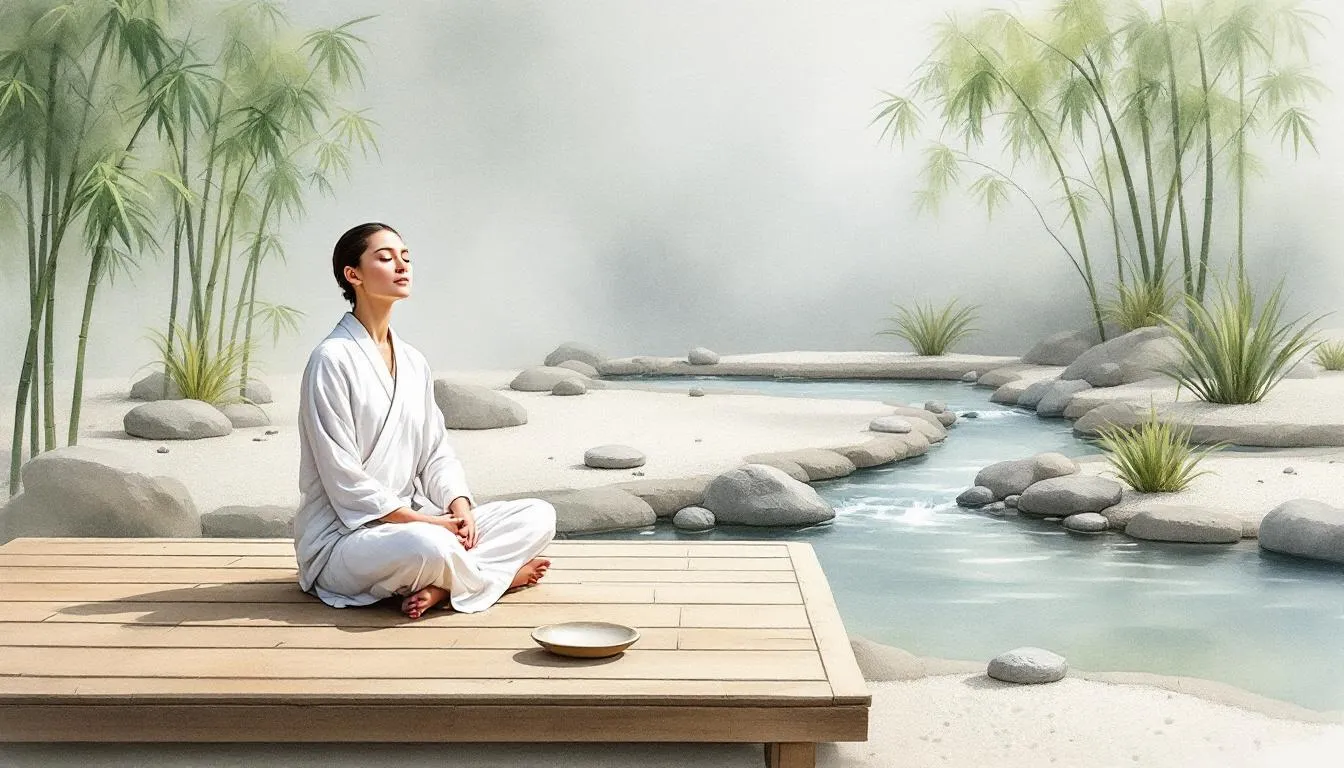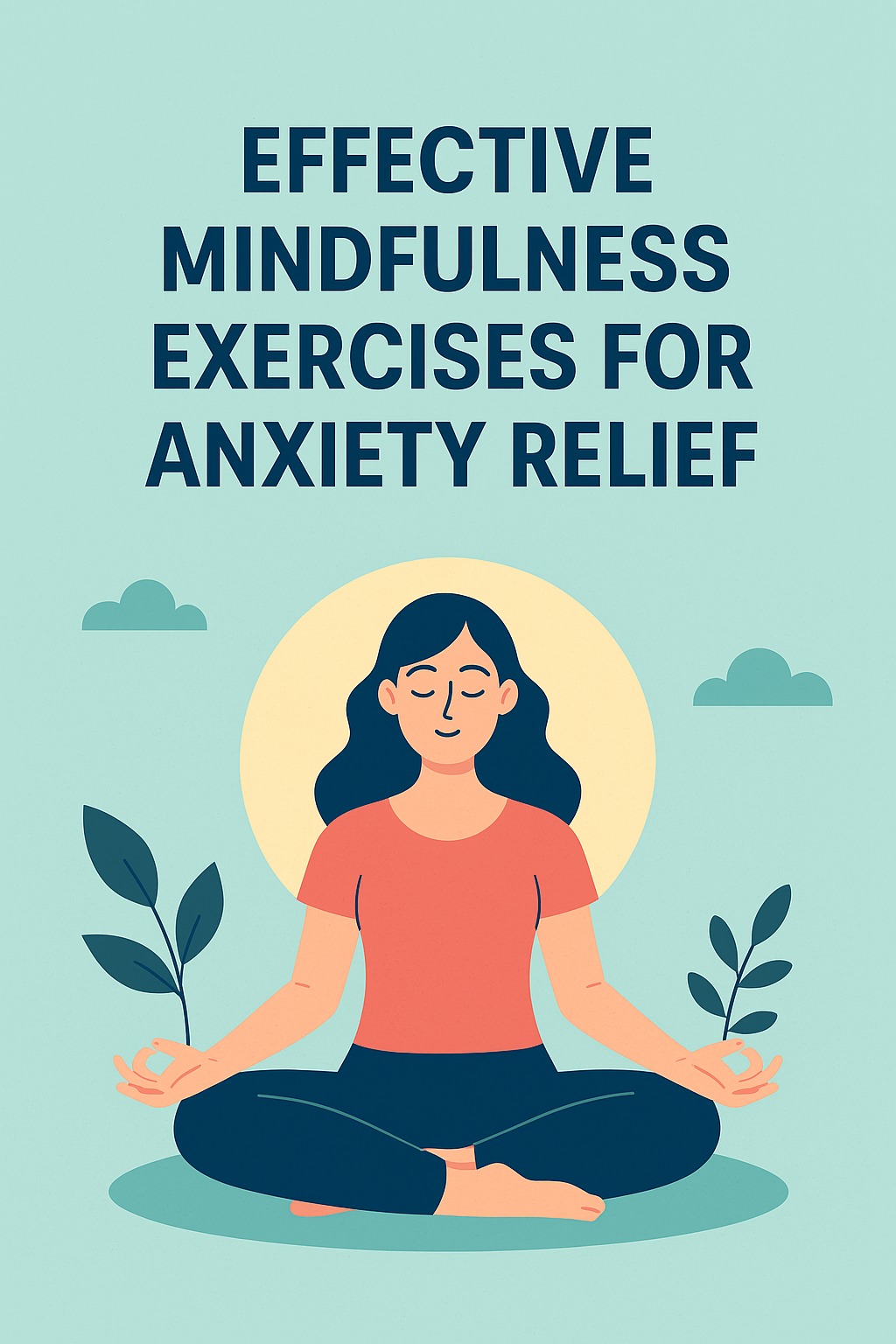Effective Mindfulness Exercises for Anxiety Relief
Looking for mindfulness exercises for anxiety to ease your worries? This article explores practical techniques to help reduce anxiety and promote calm.
🌿 Ready to turn calm into a daily habit? Let’s talk about creating a personalized mindfulness plan that fits your life.
👉 Book your free 15-minute call here.
Key Takeaways
- Mindfulness meditation enhances self-awareness and acceptance of thoughts, helping to reduce anxiety and improve overall mental health.
- Breathing exercises, such as deep breathing techniques and quick meditations, provide immediate calm and are effective tools for managing acute anxiety.
- Incorporating mindfulness into daily activities, such as eating and walking, strengthens the ability to remain present and reduces anxiety over time.
Understanding Anxiety and Mindfulness

Anxiety can feel like a relentless storm, but mindfulness offers a lighthouse amidst the chaos. Mindfulness helps individuals accept their thoughts and emotions, playing a vital role in managing anxiety. Instead of being swept away by the currents of fear and worry, mindfulness encourages us to anchor ourselves in the present moment, allowing us to observe our mental, emotional, and physical processes with clarity.
The goal of practicing mindfulness meditation is to become intensely aware of one’s feelings and sensations in the moment, without judgment. This heightened awareness helps us experience thoughts and emotions with greater acceptance, reducing the power they hold over us. Regular practice of mindfulness training can lead to improved attention and reduced symptoms of anxiety and stress, highlighting the benefits of meditation.
Mindfulness is not just about mindfulness-based stress reduction; it’s about embracing ourselves with kindness and compassion. Accepting our current experiences with kindness helps cultivate greater self-awareness and relaxation. This practice of mindfulness meditation not only reduces stress but also enhances our overall mental and physical health.
💬 Struggling to quiet your mind or stay present? You don’t have to figure it out alone.
Let’s explore how mindfulness techniques can work specifically for your situation.
📅 Book your complimentary session now.
Breathing Exercises for Immediate Calm

In moments of acute anxiety, breathing exercises can serve as a lifeline. These exercises are effective tools for reducing stress and anxiety quickly, grounding us in the present and helping to calm our racing minds. Mindfulness meditation practice often begins with focusing on the breath, a simple yet powerful way to center ourselves.
Breathing exercises can be performed in various positions, whether standing, sitting, or lying down, to promote comfort and enhance relaxation. Focusing on the present moment through mindful breathing significantly reduces anxiety and stress, fostering a sense of calm and balance.
Deep Breathing Techniques
Deep breathing techniques, such as diaphragmatic breathing, focus on taking deep, abdominal breaths to activate the body’s relaxation response. This method involves engaging the diaphragm fully, allowing for deeper breaths and better oxygen exchange, which can lead to significant stress reduction.
One effective technique is the 4-7-8 breathing method. This involves inhaling for four seconds, holding the breath for seven seconds, and exhaling for eight seconds. Practicing this method promotes tranquillity and relaxation. Taking a deep breath can enhance the effectiveness of this technique.
Breathing in through the nose and out through the mouth, focusing on a steady rhythm, can further enhance the calming effects.
5-Minute Breathing Meditation
A quick 5-minute breathing meditation can be a game-changer for those short on time. Here’s how to do it:
- Find a comfortable position to allow for optimal relaxation.
- Once settled, focus on your breath.
- Inhale through your nose.
- Exhale through your mouth, letting go of any tension.
During the 5-minute meditation, direct your attention to your breath and allow any intrusive thoughts to drift away. This practice reinforces calmness and helps anchor you in the present moment, providing a brief but effective respite from anxiety. Just a few minutes of mindful breathing can make a significant difference in your day.
🧘♂️ Your breath is the bridge between chaos and calm.
Learn how to use it to dissolve anxiety — not just manage it.
💡 Schedule a 15-minute strategy call.
Body Scan Meditation for Relaxation

Body scan meditation is a transformative technique that enhances body awareness and reduces physical sensations of anxiety through focused attention. By systematically focusing on different areas of the body, we can observe and release tension, promoting relaxation and a sense of calm through body scans.
This practice involves observing bodily sensations across the entire body, helping us recognize stress signals like tension and discomfort, including physical pain, without judgment. Through regular body scan meditation, we can cultivate a deeper connection with our physical selves, leading to improved mental and physical health and understanding how the body feels.
Full Body Scan Meditation
The full body scan meditation emphasizes a structured approach, directing attention to specific body areas to promote relaxation and stress relief. To practice, one can lie down or sit comfortably, focusing on breathing and gradually directing awareness through the body.
This meditation involves concentrating on each body part in sequence, starting from the toes and moving up to the head. Mentally examining the body and focusing on sensations like relaxation or tension in each area helps achieve a profound state of mindfulness and relaxation through sitting meditation.
Quick Body Scan for Busy Schedules
In our busy world, finding time for a full-body scan meditation might be challenging. A quick body scan meditation is designed to help individuals quickly tune into their body’s sensations, promoting relaxation and awareness even during hectic schedules.
Taking just a few minutes to close your eyes, focus on your breath, and systematically check in with each part of your body can provide a brief moment of respite and enhance overall mindfulness exercises. You can also practice meditation to deepen this experience.
🌸 Mindfulness isn’t a solo journey — it’s a skill refined with guidance.
Discover how a few simple shifts can bring lasting peace and focus.
📲 Book your clarity call today.
Grounding Techniques to Stay Present

Grounding techniques are essential for connecting us to the present moment, effectively reducing feelings of anxiety that stem from excessive worrying about the future. These techniques help us divert our focus from distressing emotions and thoughts, anchoring us in the now.
Practicing grounding exercises alleviates feelings of anxiety and stress, promoting calm and balance. These exercises redirect our attention to the current moment, making it easier to manage anxiety and stay present.
The 5-4-3-2-1 Technique
The 5-4-3-2-1 technique is a powerful grounding exercise that enhances mindfulness by using the senses to identify various elements in our surroundings. This method involves:
- Identifying five things you see
- Identifying four things you feel
- Identifying three things you hear
- Identifying two things you smell
- Identifying one thing you taste This promotes mindfulness and provides a grounding exercise during moments of anxiety.
Sensory Awareness Exercises
Sensory awareness exercises are fundamental aspects of mindfulness that help anchor us in the present moment. Mindful eating, for example, encourages savouring each bite and being aware of the flavours and textures of food. Engaging fully with the sensory experience of food enhances mindful eating and overall mindfulness.
Enhancing sensory awareness can improve overall mindfulness, reduce anxiety, and promote a sense of calm in daily activities. By focusing on external stimuli such as textures, sounds, and scents, we can heighten our awareness of the present moment and strengthen our mindfulness practice.
🌍 When life feels overwhelming, grounding starts with the right tools — and the right coach.
Let’s explore how to make these mindfulness habits stick.
🔗 Reserve your 15-minute call now.
Guided Meditations for Anxiety Reduction

Guided meditations are structured practices that promote relaxation and help ease anxiety. These meditations provide a focused approach to mindfulness, making it easier to practice even for beginners. Mindfulness-based therapies can enhance these benefits.
Apps like Insight Timer offer a wide range of guided meditations aimed at alleviating anxiety and providing accessible tools for stress reduction.
Loving-Kindness Meditation
Loving-kindness meditation aims to reduce negative emotions and increase positive feelings. This practice involves cultivating compassion and kindness towards oneself and others. The Loving-Kindness Heartscape Meditation, led by Jon Kabat-Zinn, promotes deep healing and emotional well-being.
Focusing on positive emotions through loving-kindness meditation enhances overall mental and physical health, making it a valuable tool for managing anxiety and stress. This meditation practice helps cultivate a sense of connection and empathy, further reducing anxiety symptoms.
Guided Visualization for Stress Relief
Guided visualization is a practice that helps create a mental escape from anxiety-inducing thoughts. By imagining a peaceful scene or scenario, we can transport ourselves away from stress and into a state of relaxation. This technique is particularly helpful for those who struggle with intrusive thoughts and need a break from their anxiety.
Studies suggest that guided visualization can significantly reduce stress and improve mood, making it an effective tool for managing anxiety. Incorporating guided visualization into mindfulness practice enhances the ability to cope with stress and maintain calm, leading to decreased stress.
Practicing Mindfulness in Daily Activities
Integrating mindfulness into daily tasks can help manage stress and maintain a calm demeanour. Simple practices such as mindful eating and mindful walking can transform routine activities into opportunities to increase mindfulness. Focusing on moment-to-moment sensations during everyday activities strengthens the ability to remain present and reduces anxiety, enhancing mindfulness skills.
Mindfulness can be effectively practiced during routine tasks such as washing dishes or showering. This practice of single-tasking and focusing fully on one activity at a time enhances our overall mindfulness practice experience and promotes mental clarity. Mindfulness works to deepen our engagement in these moments.
🍃 Small changes in awareness lead to big shifts in calm and confidence.
I’ll help you integrate mindfulness seamlessly into your daily routine.
📅 Schedule your free session.
Mindful Eating
Mindful eating involves slowing down the process of eating and being fully present. Focusing on breath awareness and the sensations of air moving in and out deepens mindfulness in the moment. Noticing the belly rising and falling and the temperature change of the breath further enhances this practice.
Practicing mindfulness while eating can significantly reduce anxiety and enhance overall well-being. Keeping a journal of mindfulness practice can assist in recognizing patterns in anxiety symptoms, providing valuable insights into our mental state.
Mindful Walking
Mindful walking is a simple practice that involves being fully present and aware of the physical sensations experienced while walking. By focusing on the sensations of your feet making contact with the ground and your breath, you can enhance your body awareness and stay anchored in the present.
Regular practice of mindful walking can lead to reduced anxiety and improved overall mental well-being for healthy individuals. This practice integrates mindfulness into daily life, enhancing both physical and mental health, and providing a refreshing break from the hustle and bustle of everyday activities.
Building a Regular Mindfulness Practice
Establishing a routine is crucial for long-term mindfulness practice. Starting with a meditation class or using a guided tape can be a good approach to building a consistent practice. Regular practice of calming breathing techniques can maximize their benefits in reducing stress and anxiety.
More practice leads to more effects, so daily practice or frequent mindfulness practice is encouraged. Mindfulness practice is not about perfection; it is a process that evolves over time.
Every moment is an opportunity to begin again in mindfulness practice; it’s a practice to return to when needed.
Setting Up a Routine
Setting up a regular routine for mindfulness practice involves:
- Establishing a consistent time for meditation
- Enhancing the effectiveness of the practice
- Making it easier to integrate mindfulness into daily life
- Dedicating a specific time each day to create a habit that supports mental clarity and reduces stress.
Tracking Progress
Tracking progress in mindfulness practice is crucial for seeing improvements and adjusting techniques. Establishing a consistent mindfulness routine involves choosing a quiet space, setting a timer, and determining a suitable time of day for practice. This structured approach provides a foundation for managing anxiety symptoms effectively.
Research suggests that regular mindfulness practice can significantly impact anxiety relief. Tracking your progress deepens your understanding of anxiety management and helps make necessary adjustments to your practice. This ongoing evaluation helps sustain and enhance the benefits of mindfulness.
Summary
The journey through various mindfulness exercises reveals a powerful toolkit for anxiety relief. From deep breathing techniques to body scan meditations, and from grounding exercises to guided meditations, each practice offers unique benefits. Integrating mindfulness into daily activities further enhances its effectiveness, providing a practical approach to managing stress and anxiety.
Embracing mindfulness is not just about reducing anxiety; it’s about fostering a deeper connection with ourselves and our surroundings. By building a regular mindfulness practice, we can cultivate a sense of calm, clarity, and resilience. Start today, and experience the transformative power of mindfulness in your life.
✨ Mindfulness is powerful — but personalized guidance accelerates your growth.
Take the first step toward lasting calm and clarity.
👇 Book your complimentary 15-minute call today.
Frequently Asked Questions
How does mindfulness help with anxiety?
Mindfulness reduces anxiety by enabling individuals to accept their thoughts and emotions non-judgmentally, which diminishes anxiety’s influence. This practice fosters greater emotional regulation and resilience against stress.
What are some quick mindfulness exercises I can do during a busy day?
Incorporating breathing exercises, quick body scans, and grounding techniques such as the 5-4-3-2-1 method can significantly enhance your mindfulness even during a hectic day. These practices provide immediate relief and help refocus your mind amidst busyness.
How can I integrate mindfulness into my daily activities?
Integrating mindfulness into your daily activities can be achieved by concentrating on the sensations and experiences of routine tasks like washing dishes, showering, or walking. This practice helps anchor you in the present moment and enhances awareness.
What is the 4-7-8 breathing technique?
The 4-7-8 breathing technique is a method for relaxation where you inhale for four seconds, hold your breath for seven seconds, and exhale for eight seconds. This practice can help reduce stress and calm the mind.
How do I start a regular mindfulness practice?
To start a regular mindfulness practice, establish a consistent time for your sessions, utilize guided practices or classes, and monitor your progress to enhance your experience. This structured approach will help you cultivate mindfulness effectively.



